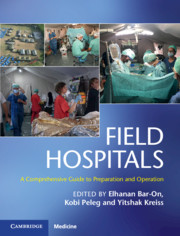Book contents
- Field Hospitals
- Field Hospitals
- Copyright page
- Contents
- Contributors
- Preface
- Section 1 History
- Section 2 Scenarios
- Chapter 3 Definitions, Needs, Scenarios, Functional Concept, and Modes of Deployment
- Chapter 4 Needs Assessment
- Chapter 5 Predeployment Operational Planning and Preparations
- Section 3 Operational Considerations
- Section 4 Clinical Considerations
- Section 5 Additional Contextual Considerations
- Index
- Plate Section (PDF Only)
- References
Chapter 5 - Predeployment Operational Planning and Preparations
from Section 2 - Scenarios
Published online by Cambridge University Press: 09 January 2020
- Field Hospitals
- Field Hospitals
- Copyright page
- Contents
- Contributors
- Preface
- Section 1 History
- Section 2 Scenarios
- Chapter 3 Definitions, Needs, Scenarios, Functional Concept, and Modes of Deployment
- Chapter 4 Needs Assessment
- Chapter 5 Predeployment Operational Planning and Preparations
- Section 3 Operational Considerations
- Section 4 Clinical Considerations
- Section 5 Additional Contextual Considerations
- Index
- Plate Section (PDF Only)
- References
Summary
This chapter deals with the modalities of the actions to be taken prior to the deployment of a field hospital to a foreign country in a disaster. It specifically examines the necessity and role of a recce mission, which should deploy before thefield hospital does. It covers the issues that the recce mission will face on arrival in a foreign country and the actions it should take to tackle these. It also deals with the specific duties of a recce mission in terms of establishing liaison with the host government and the coordination structures established at the disaster site. Actions that need to be taken for the smooth entry of the field hospital into the country and its deployment to the site are covered in detail from site selection for the field hospital to immigration and customs issues. It also covers the handing over of responsibility from the recce mission to the main body of the field hospital. The chapter includes numerous references to handbooks and articles that deal with international deployment and ends in some "take-home" conclusions for a team.
Keywords
- Type
- Chapter
- Information
- Field HospitalsA Comprehensive Guide to Preparation and Operation, pp. 34 - 40Publisher: Cambridge University PressPrint publication year: 2020



